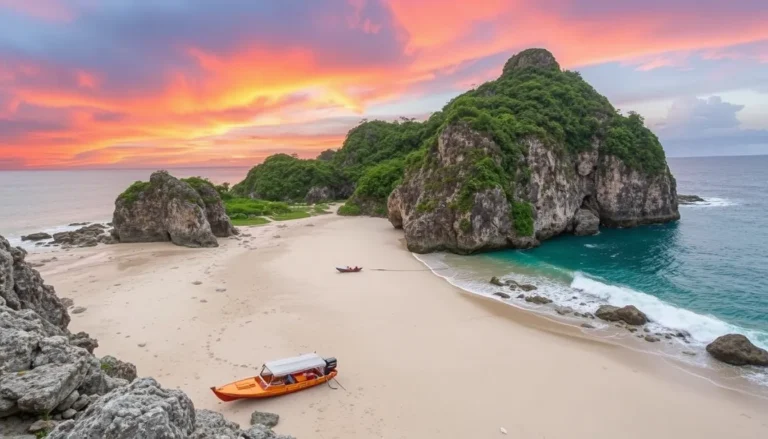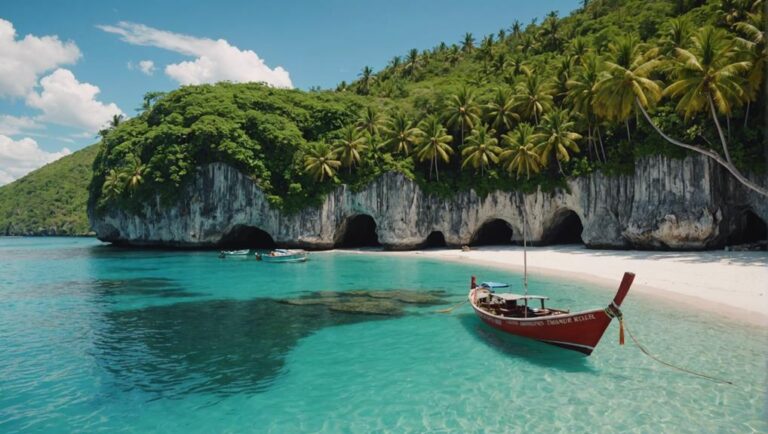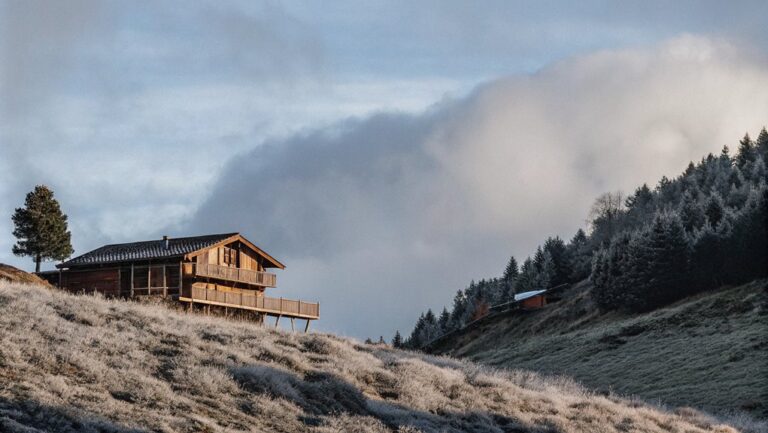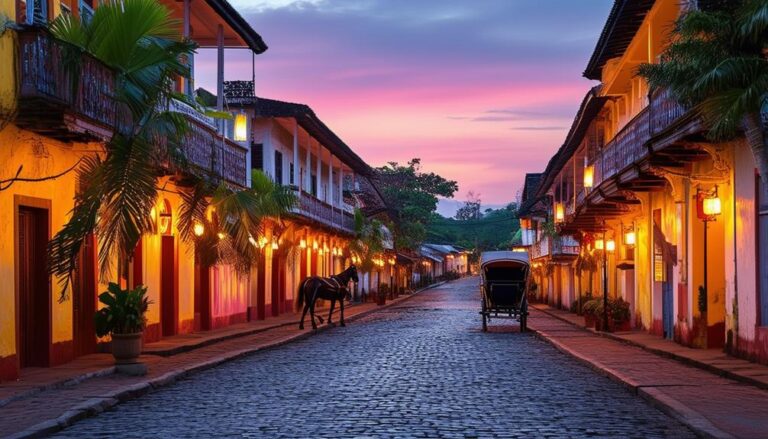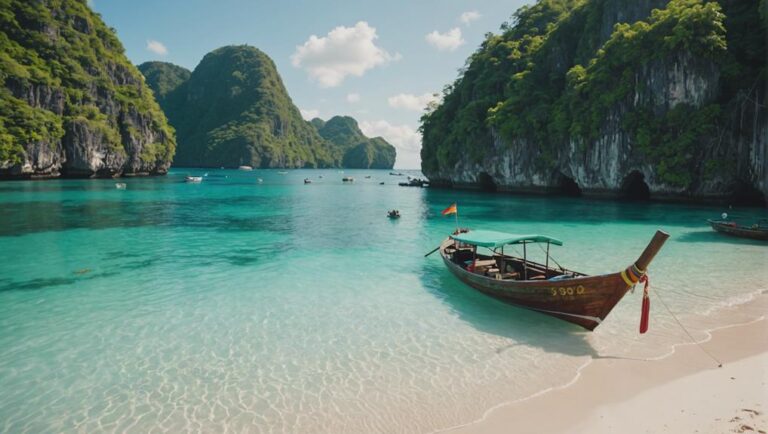Chocolate Hills Philippines
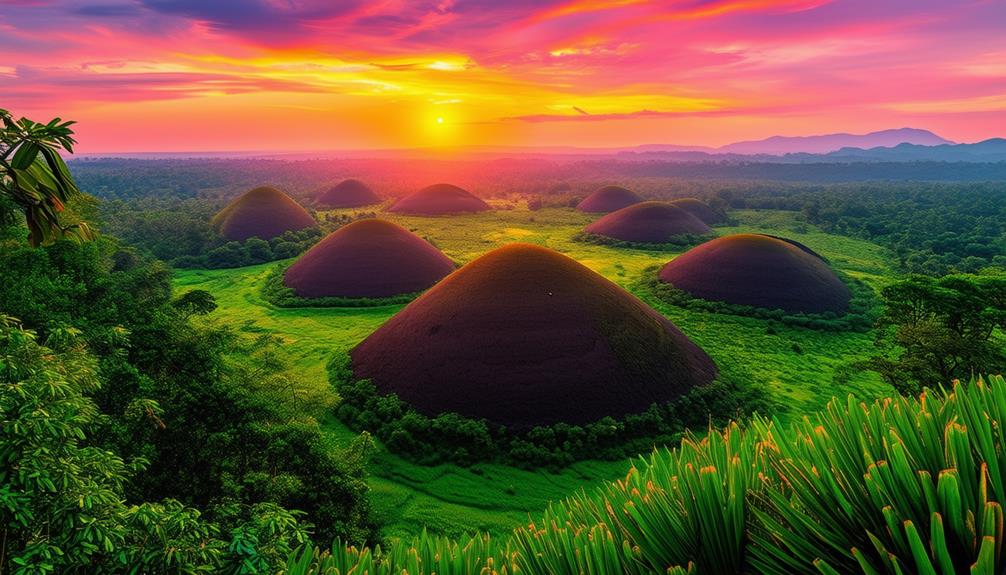
You’ll discover that the Chocolate Hills in the Philippines are a stunning example of karst topography, comprised of over 1,700 conical limestone hills. These hills are formed by a combination of sediment deposition, tectonic uplifting, and extensive erosion processes over thousands of years.
During the dry season, they’re a striking brown, resembling vast rows of chocolate drops, transforming to a vibrant green in the wet season. This dynamic geological shift highlights the hills’ unique dependency on precipitation patterns.
The entire landscape has earned recognition as a National Geological Monument. There’s much more to uncover about these fascinating formations.
Key Takeaways
- Chocolate Hills consist of over 1,700 conical limestone formations in the Philippines, recognized for their unique geological characteristics.
- These hills are famous for their colour transformation from green during the rainy season to brown in the dry season.
- Designated as the Philippines’ third National Geological Monument, efforts are ongoing to obtain UNESCO World Heritage status.
- Tourists can enjoy panoramic views from viewing decks at Chocolate Hills Complex and Sagbayan Peak, especially during the dry season.
- Conservation measures are in place to protect the area from erosion and excessive tourism, promoting sustainable environmental practices.
Exploring the Landscape
Exploring the landscape of the Chocolate Hills reveals a unique geological formation of over 1,700 conical limestone peaks, each standing as evidence of the area’s dynamic Earth processes. As you traverse this iconic terrain, you encounter the sheer magnitude of these natural wonders, recognized globally for their distinctive, conical karst shapes.
Each peak, primarily composed of grass-covered limestone, has been sculpted over millennia through a complex combination of dissolution, tectonic processes, and erosion.
The peaks’ most dramatic transformation occurs during the rainy season when the vegetation flourishes, draping the hills in lush greenery, contrasting starkly with their dry season appearance when they resemble vast fields of chocolate hence their name. This seasonal variation isn’t just a visual spectacle but also a dynamic illustration of geological change in real time.
As a protected area, efforts are in place to preserve the pristine condition of these limestone peaks. You’re encouraged to view these geological marvels from established viewing decks. The decks provide strategic vantage points without causing harm to the delicate karst landscape.
Historical and Cultural Significance
The Chocolate Hills aren’t only a geological marvel but also a canvas rich with cultural narratives, deeply rooted in local legends and historical significance. These hills, ranging in number from 1,268 to 1,776, embody a surreal landscape that transforms from lush green to a striking brown during the dry season, enhancing their historical allure.
Local legends suggest these formations are either the remnants of a titanic clash between giants or the petrified tears of a heartbroken giant, weaving a rich network of myth into the geological history of the area.
You’ll find that the hills’ cultural significance is further underscored by their designation as the Philippines’ third National Geological Monument. This recognition not only emphasizes their unique geological characteristics but also their pivotal role in the cultural and historical narrative of the region.
It’s here, from the strategically placed viewing decks, that you’re invited to immerse yourself in the panoramic vistas of this iconic terrain. The absence of climbing opportunities is compensated by the extensive views these decks offer, ensuring a full appreciation of the Chocolate Hills without altering their natural state.
Conservation Efforts
Conservation efforts for Chocolate Hills prioritize the delicate balance between accommodating tourists and preserving this unique geological landscape. As a protected area since 1997, these iconic hills face continuous threats from both natural erosion and human-induced pressures, such as quarrying activities. Your understanding of these dynamics is vital to appreciating the ongoing conservation initiatives aimed at safeguarding the hills’ geological significance.
The geologists classify this area as conical karst topography, a rare geological formation that contributes greatly to the landscape’s aesthetic and scientific value. This classification underlines the necessity for stringent conservation measures that not only restrict detrimental activities like quarrying but also ensure that tourism development doesn’t compromise the site’s integrity.
Efforts to secure UNESCO World Heritage status for the Chocolate Hills highlight the global recognition of their value and the need for international standards in conservation practices. This status would enhance global awareness and potentially increase support for conservation initiatives, ensuring the hills are preserved for future generations.
Conservation measures currently focus on a multifaceted approach: regulating access to sensitive areas, promoting eco-friendly tourism practices, and engaging local communities in preservation efforts. These measures are designed to balance tourism development with environmental sustainability, ensuring that the influx of tourists bolsters rather than undermines conservation efforts.
Your role in this conservation effort is more than passive observation; it’s an active engagement with practices that support sustainable tourism and help maintain the ecological balance crucial to the preservation of the Chocolate Hills.
Tourist Information
Understanding the geological uniqueness and conservation status of the Chocolate Hills enhances your appreciation when visiting this extraordinary landscape. These conical limestone formations, a result of millennia of erosional processes, form a breathtaking geomorphological feature within Bohol Province.
When planning your visit, you’ll find detailed tourist information available to guarantee you fully experience the beauty of this site. The Chocolate Hills Complex and Sagbayan Peak offer strategically positioned viewing decks that provide panoramic views of this extensive landscape, especially picturesque during the dry season when the hills resemble vast fields of chocolate drops.
To fully appreciate the scientific and aesthetic value of the Chocolate Hills, consider the following:
- Geological Perspective: Understand the karstic nature of these limestone mounds, formed by the dissolution of a kind of limestone called marl and subsequent subaerial exposure.
- Conservation Status: Recognize the efforts in conserving this site as a protected area, which helps preserve its pristine condition against anthropogenic pressures.
- Optimal Visit Times: Plan your visit during the dry season for the iconic ‘chocolate’ appearance of the hills, although they possess a different kind of allure when green during other times of the year.
Environmental Challenges
Environmental challenges facing the Chocolate Hills include the contentious development of Captains Peak Garden and Resort, raising significant concerns about the adherence to protective regulations. Amidst the lush terrain of this national geological monument, the resort’s establishment has sparked a robust dialogue on environmental protection and the preservation of geological treasures.
The resort’s inception within a protected area has led to scrutiny regarding its compliance with stringent environmental regulations. Critics argue that the construction could have a lasting ecological footprint, potentially affecting the delicate limestone formations that define the Chocolate Hills. These formations, shaped over millennia, are susceptible to even minimal ecological disturbances.
You must consider how soil erosion, water runoff, and habitat disruption from construction activities could irreversibly impact the local biodiversity and geological stability. The resort claims to have minimized its ecological footprint, yet the effectiveness of such measures in a highly sensitive area remains a topic of intense debate.
Furthermore, the local community and environmental advocates are questioning the transparency of the approval process. They’re concerned about possible circumventions of environmental laws designed to protect such a unique landscape. The situation underscores the critical need for robust enforcement of environmental regulations to ensure that development activities don’t undermine the integrity of protected areas.
What Are Some Other Must-See Attractions in the Philippines Besides Chocolate Hills?
Aside from the famous Chocolate Hills, one must-see attraction in the Philippines is Star City Amusement Park Philippines. It offers a wide variety of rides and attractions suitable for all ages. From thrilling roller coasters to entertaining shows, it’s a fun-filled destination for locals and tourists alike.
Frequently Asked Questions
Why Is the Chocolate Hills Famous?
They’re renowned for their unique geologic formation, consisting of over 1,700 cone-shaped limestone hills, which transform from lush green to brown in the dry season.
What Is the Legend of the Chocolate Hills in the Philippines?
A few common legends include that these are the grounds where the giants are battling, throwing stones, or giants mourning their love with tears that formed these hills, blending folklore with the geology of this unique, treeless limestone landscape.
Where Are the Chocolate Hills Located in the Philippines?
You’ll find the Chocolate Hills in Bohol, Philippines, forming a striking karst landscape of conical shapes, primarily from limestone, spread over approximately 50 square kilometres in the towns of Carmen, Batuan, and Sagbayan.
How Much Does It Cost to Go to the Chocolate Hills in the Philippines?
You’ll typically spend about 500 to 1000 Philippine Pesos for a basic visit, excluding accommodations. This includes entrance fees and local transport costs, ensuring a thorough exploration of this geologically significant site.
Conclusion
As you conclude your visit to the Chocolate Hills, it’s essential to recognize the delicate interplay of natural forces that shaped this unique karst landscape. Formed over millennia by the dissolution of limestone and subsequent erosion, these conical mounds underscore the dynamic geological processes of our planet.
Continued conservation efforts are crucial in preserving their aesthetic and ecological integrity against the backdrop of climatic variabilities. Embrace this majestic geological phenomenon, a testimony to Earth’s ever-evolving nature.

